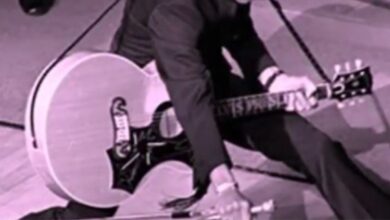Experience The Mesmerizing 21-Year-Old Elvis Performing – Sheer Brilliance!
Elvis Presley’s iconic performance of “Blue Suede Shoes” in 1956 represents a pivotal moment in the evolution of rock and roll music, acting as a catalyst for a cultural revolution within the United States and beyond. Originally penned and recorded by Carl Perkins in 1955, the song had already garnered attention for its catchy rhythm and relatable lyrics, but it was Elvis’ rendition that transformed it into a phenomenon. When he brought the song to life with his unique style, it became an anthem for a generation eager for change in the musical landscape.
The context surrounding Elvis’s performance highlighted the burgeoning youth culture of the 1950s. Teenagers were searching for their own identity, separate from previous generations, and rock and roll embodied that desire for freedom and self-expression. “Blue Suede Shoes,” with its themes of rebellion and personal pride, resonated deeply with young audiences. Elvis, with his sleek hairstyle and sharp clothing, wasn’t just a performer; he became a symbol of this new cultural movement, and the way he carried himself on stage spoke volumes about the era’s shifting values.
During his live performances, Elvis showcased a mesmerizing blend of rhythm, blues, and country music, bringing an infectious energy to the stage that was unlike anything seen before. In “Blue Suede Shoes,” his performance was punctuated by energetic dance moves that emphasized the song’s upbeat tempo. The fusion of music and dance created a sense of excitement that was palpable to those watching. Many viewers experienced an adrenaline rush as Elvis delivered the song with an unparalleled enthusiasm, helping to forge a connection between the artist and his audience.
Musically, “Blue Suede Shoes” is constructed around a simple yet infectious chord progression that complements its upbeat lyrics. Elvis’s vocal abilities added a layer of emotion and authenticity that enhanced the song’s appeal. His powerful voice created an engaging experience, enabling audiences to feel the joy and confidence expressed in the lyrics. The performance not only highlighted his talent as a singer but also demonstrated his skill as an entertainer who understood the importance of visual presentation in music.
The impact of Elvis’s version of “Blue Suede Shoes” transcended mere commercial success. It propelled the song to the top of the charts, making it an immediate classic and further extending its reach into popular culture. Elvis’s interpretation helped to define what rock music would become—energetic, rebellious, and filled with a youthful exuberance that appealed to many. The song’s enduring popularity can be traced through multiple generations, as later artists revisited the classic and paid homage to Elvis’s revolutionary impact on music.
Elvis’s ascendance to fame coincided with the rise of television as a primary source of entertainment. His performances on shows such as “The Ed Sullivan Show” allowed him to reach a broader audience, showcasing his charisma and talent to millions. The infamous swiveling of his hips and charismatic expressions made him a controversial figure at the time, with many adults criticizing his style as provocative. Nonetheless, this controversy only fueled his popularity among young fans, who viewed him as a rebel icon challenging societal norms.
In the years following his groundbreaking performance, Elvis continued to evolve as an artist, exploring various musical genres and styles. He ventured into films, releasing several successful movies that showcased his talents while further solidifying his status as a cultural icon. Despite his diversified career, “Blue Suede Shoes” remained a cornerstone of his musical repertoire, and he often revisited the song in live performances throughout his career.
Elvis’s influence extended beyond music; it permeated fashion, dance, and overall youth culture, making him a shaper of trends during the 1950s and 60s. The rockabilly style he popularized influenced countless musicians who followed, while his innovative approach to performance paved the way for future generations of artists. His ability to break barriers and reach diverse audiences fueled the merging of different musical genres, a concept that would define much of popular music in the decades that followed.
Even today, the legacy of Elvis Presley and “Blue Suede Shoes” remains alive. Countless artists have cited him as a significant influence on their work, often emulating his style and stage presence. The song itself continues to be performed, covered, and celebrated in various forms, showcasing its timeless appeal and the universal themes of self-identity and rebellion that it encapsulates. Through “Blue Suede Shoes,” Elvis not only left a permanent mark on rock music but also inspired a spirit of confidence and individuality that resonates with many.
In retrospect, Elvis Presley’s impactful performance of “Blue Suede Shoes” was much more than a simple musical moment; it was the spark that ignited a cultural shift. By bridging the gap between different musical styles, captivating audiences, and challenging societal norms, Elvis secured his place as the “King of Rock and Roll.” His contributions to music, culture, and entertainment remain influential, ensuring that his legacy will endure for future generations.



